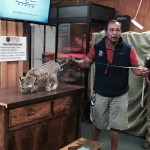It’s difficult to watch — these two mountain lions devouring rats — and I try to remember it’s all about the Circle of Life. The big cats walk nimbly out on large limbs, recently installed in their enclosure, and slurp up their treats who are, fortunately, already dead.

I’m just glad there is lots of glass between me and these lions, sisters named Cascade and Canyon. They are two of the 128 residents of the Big Bear Alpine Zoo in Big Bear Lake. Like their cohorts who have been saved from abandonment, illness and disability, Cascade and Canyon have a story. Their mother was shot in 2002 by a rancher while she was searching for food for her cubs. The 4-week-olds came to the zoo after being treated for intestinal problems by the U.S. Fish and Wildlife Service. Their care by humans meant their instincts were altered and they could not be released into the wild.
The staff says they are the most easy-going mountain lions the zoo has ever had. I guess I’ll just have to take their word for it.
We meet these mountain lions, as well as owls, raccoons, wild boar, a bobcat, bald eagles, snow leopards and foxes, during the zoo’s Flashlight Safari, a two-hour tour that allows visitors to discover animal action after sundown.
“There’s a lot of activity at night,” explains curator Bob Cisneros, who comes to this animal rehabilitation facility after more than two decades as animal care supervisor at the San Diego Zoo.

“We get coyotes howling at one end of the zoo and wolves howling at the other end. And you will never hear the owls hooting during the day.”
Cisneros arrived in March with a mission to improve the lives of the animals and enhance the visitor experience. For him, it was a golden opportunity.
“I felt that 20 years of my knowledge and experience prepared me for a new leadership role and that I could take everything I’ve learned and apply it to another place,” he says. “Plus I’ll have the opportunity to build a new zoo – to bring it into the 21st century. Who gets to do that?”
To put things into perspective, the San Diego Zoo has a budget of $250 million; this zoo has between $1.5 million and $2 million.
Later during our Flashlight Safari, Cisneros tosses handfuls of peanuts over the high fence that contains eight raccoons. They pounce on as many peanuts as they can as fast as they can. We know the competition is fierce when we hear the raccoons hiss and snarl. Some avoid the fray and reach outside the fence to scoop up peanuts that have fallen there. It’s fascinating to watch their fine-fingered movements as they separate the peanuts from the shells.
We also drop by a new enclosure that is home to Asha and Shanti, Himalayan snow leopards and sisters, born with a genetic eye disease that causes blindness. They were originally part of the Species Survival Program at the Woodland Park Zoo in Seattle. Rather than euthanize the cats to remove them from the gene pool, the Big Bear Alpine Zoo welcomed them with open arms.
Both have had their right eyes removed to prevent further complications and infections. Their brother had to be euthanized because of an untreatable heart condition.
After their arrival in June 2014, and it took a while for Asha and Shanti to acclimate, but now the regal cats are on display daily.
Big Bear Alpine Zoo is the only zoo in San Bernardino County and one of only two alpine zoos in the country. It is open year-round, weather permitting.
The Flashlight Safari continues 6:30 p.m. to 8:30 p.m. Fridays and Saturdays through October. Admission $12 adults; $9 seniors and children ages 3 to 10. Free if under 3.
Visit bigbearzoo.org or call (909) 584-1299.
E’Louise Ondash is a freelance writer living in North County. Tell her about your travels at [email protected]

